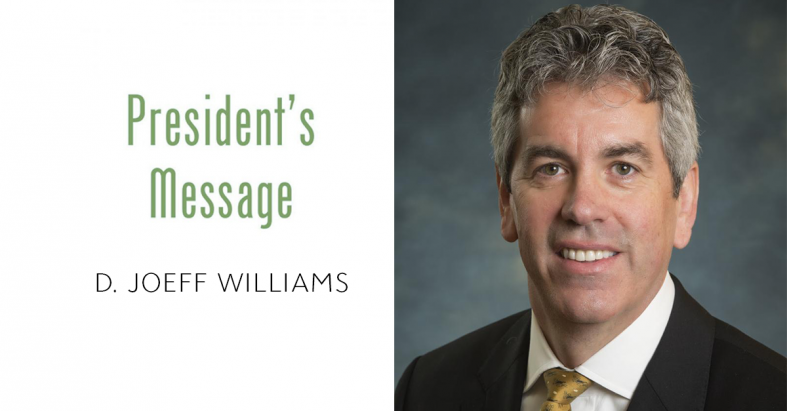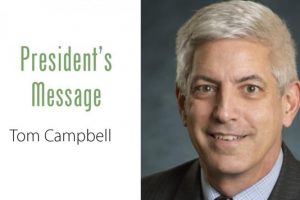By D. Joeff Williams
In my first President’s Message, I wrote about there being “more to the picture,” with some observations in the context of classical paintings vis-a-vis the Academy’s motto, “Objective. Independent. Effective.” This has led me to think a little deeper and see some more analogies in the “layers of history”—that quality in paintings that can serve as a metaphor as to how the Academy’s professionalism efforts have evolved over the years.
Recent forensic analysis has shown that a number of classic paintings have other, earlier paintings or sketches by the artist below them. X-ray scans have found such examples in Picasso’s “Blue Room,” Van Gogh’s “Patch of Grass,” and Goya’s “Portrait of Don Ramón Satué,” among others. The reasons for the overlays vary—in some cases the artist simply couldn’t afford a new canvas, while other artists’ work evolved or they radically changed their styles or even their subject—but a common theme is that they were all building on something that had come before, in their ideas and their work.
Uncovering classic paintings isn’t the only way in which we’ve seen layers of history. On a recent trip to Israel, I spent several days in Jerusalem. Having some spare time to just wander through the walled portion of the Old City section, I was reminded of the many layers of history that are hidden from what we see today. The Old City’s history goes back more than 4,000 years, and included many cultures and stories that occurred over that period. The vast number of societies—whether Canaanite, Israelite, Assyrian, Babylonian, Roman, Byzantine, Ottoman, and many more—all speak to the rich history and value of this area geographically, culturally, and, many would say, spiritually. The area has been central to civilizations for centuries.
So, what we see today is not always reflective of the totality of history that has come before.
This idea can apply similarly to the Academy’s professionalism evolution over our 55-year history. That includes the creation of the Actuarial Standards Board (ASB) in 1988—which, with the recent Modeling actuarial standard of practice (ASOP), has now adopted 56 ASOPs—and the Actuarial Board for Counseling and Discipline (ABCD) in 1991. The former grew from an interim ASB, which was created three years earlier. The ABCD continues to highlight its work in requests for guidance (RFGs), a growing area of opportunities for actuaries to practice professionalism. (There were more than 100 RFGs in 2018.) The current Professional Code of Conduct, adopted Jan. 1, 2001, has been the fundamental basis for our professionalism infrastructure for almost 20 years after a monumental effort to achieve a Code that all of the U.S.-based organizations adopted individually as each’s own—but that 2001 edition followed an earlier “Code” that was published originally in 1970, and other variations that occurred over time among different organizations. The current U.S. Qualification Standards (USQS) have been in effect since January 2008, and, when adopted, greatly expanded the qualification requirements to include annual and relevant continuing education (CE)requirements for all those who issue any Statements of Actuarial Opinion (SAOs) in any practice area. .
A recent professionalism work is the 2017 paper “The Academy and the Web of Professionalism,” which illustrates how the elements of professionalism (the ASOPs, the ASB and the ABCD, and the USQS) all support the requirements of the Code. Academy resources include the multitude of materials, publications, and infographics that explain aspects of the Academy’s professionalism work. All of these are available from links in many places, but they’re collected in our website that we launched last year—“Professionalism First” is a watchword and a landing page that highlights our abiding “culture of professionalism” and the Academy’s place as the home of U.S. actuarial professionalism. The blogs, podcasts, videos, articles all showcase how creating a culture of professionalism is important and central to our mission and where that culture springs from.
Self-regulation is a foundational principle for our profession. That is evident in the work that was done last year in updating the Academy’s strategic plan. The plan recognizes the Academy’s dedication—right up front in Section 1.1—to “Lead the professionalism activities of the U.S. actuarial profession in clear demonstration of the profession’s ability to self-regulate.” As my predecessor Academy President Shawna Ackerman wrote, “The document reinforces our commitment to lead the professionalism activities of the U.S. actuarial profession.
So whether it’s a painting or an evolving ancient-to-modern metropolis, our first, second, and successive efforts—and what will follow—build on what’s come from the past and shape the future.





